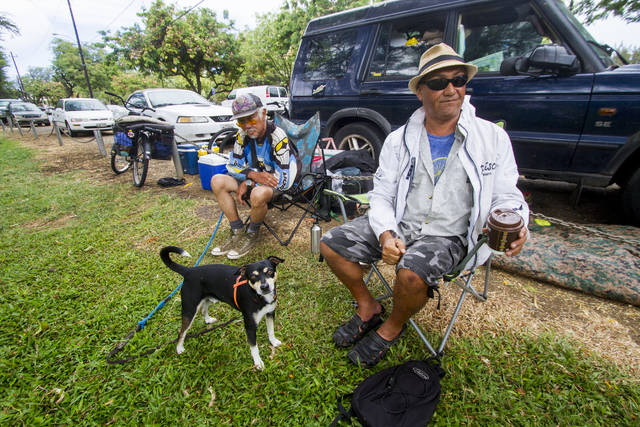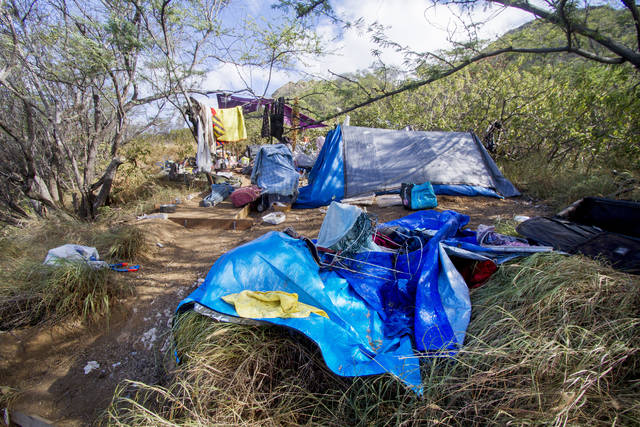Growing homeless encampments prompt proposal for armed park rangers

DENNIS ODA / DODA@STARADVERTISER.COM
“Dog,” left, who declined to give any other name, and Fabio sat in Kapiolani Park along Paki Avenue. Dog lives in the Land Rover behind him. They complain that the police harass and cite them for various violations.

DENNIS ODA / DODA@STARADVERTISER.COM
Homeless encampments such as the ones seen here litter the Diamond Head Road area and have created problems for people who use the area for recreational purposes. A homeless man filled bottles with water using a fountain on the side of Diamond Head Road and walked down the ledge to his makeshift home last month.

DENNIS ODA / DODA@STARADVERTISER.COM
A homeless encampment below Diamond Head Road overlooks the ocean. City Councilman Trevor Ozawa is working on a proposal that would create a new sector of armed park rangers who could enforce laws or rules within city parks.



Waikiki resident Jen Tema holds her breath as she jogs past the Diamond Head lookouts because most days the stench from the homeless encampments is overwhelming.
“We’re at the beginning of the toilet,” Tema said on a recent Friday as she passed by a garbage pile that spilled over the oceanside cliffs like a waterfall. “When it’s dead wind, you can barely walk by it. It’s a shame because this is one of the most beautiful places in the world.”
She quit jogging at night because she didn’t feel safe due to the security risks and health hazards that have surfaced since the neighborhood’s homeless residents began monopolizing public spaces. Her son doesn’t surf at the lookouts because homeless campers dump buckets of feces into the water there. Her kids wear shoes instead of slippers to the parks to avoid stepping on discarded drug needles and used condoms.
City Councilman Trevor Ozawa said he’s been getting similar complaints from constituents in Waikiki and other neighborhoods that he serves. Public safety is driving the need for the city to explore additional ways to keep public spaces safe, said Ozawa, who is working on legislation to create a new city agency with the power to enforce park rules.
Ozawa wants the city to ask voters to approve putting armed park rangers in city parks in a 2018 City Charter amendment. Under Ozawa’s proposal, park rangers would fall under the oversight of the city’s Department of Parks and Recreation and receive training similar to that of state Department of Land and Natural Resources officers, who carry weapons.
Ozawa envisions rangers patrolling the city’s biggest parks in Waikiki and elsewhere to address everything from illegal camping and living in cars to littering, vandalism and enforcing no-smoking policies.
Don't miss out on what's happening!
Stay in touch with breaking news, as it happens, conveniently in your email inbox. It's FREE!
PARK PROBLEMS MOUNTING
The number of park violations that police must respond to increased from 2015 to 2016. Also, arrests and citations in 2017 appear to be trending ahead of last year’s pace.
Park violations | 2015 | 2016 | 2017 (as of 6/17)
Warnings | 4,716* | 6,049* | 1,036
Citations | 12,978 | 15,262 | 8,312
Arrests** | 1,730 | 2,700 | 1,084
* Includes warnings issued during public education periods preceding enforcement.
** Includes all arrestable offenses, such as warrants, drugs, probation violation, etc.
“We continue to see enforcement issues, continue to have issues with our homeless population in our parks, and need to make our children’s safety a priority,” he said. “We need to continue exploring ways of keeping our park users safe and our facilities free of vandalism and destruction.”
Ozawa’s proposal is garnering support, especially in Waikiki, where city crackdowns, which ban sitting and lying on sidewalks, have had the unintended consequence of pushing homeless people into other less-policed areas like city parks. Critics say some of the people living in their cars along Paki Avenue are becoming residents and there’s an obvious permanency to some of the illegal campsites at the oceanside cliffs.
“It seems like the homeless situation in Waikiki is worse than it’s been in four years,” said Waikiki Neighborhood Board member Jeff Merz.
From 2015 to 2016, Honolulu police statistics show warnings for all offenses committed in city parks islandwide grew 28 percent, while citations rose 17 percent and arrests rose 56 percent. From 2015 to 2016, warnings for sit-lie dropped 41 percent, but citations rose 33 percent and arrests doubled. From 2015 to 2016, public urination warnings increased more than a thousandfold and citations increased by more than half, but arrests dropped by 90 percent.
Waikiki Neighborhood Board Chairman Bob Finley said he wants to see more details, but on its surface Ozawa’s park ranger proposal addresses his concerns about homeless people evading Honolulu police.
CREATING A NUISANCE
Nuisance laws have resulted in more citations and arrests.
Sit-lie | 2015 | 2016 | 2017 (as of 6/17)
Warnings | 13,653 | 8,019 | 4,323
Citations | 328 | 430 | 269
Arrests | 9 | 18 | 0
Public urination
Warnings | 5 | 81 | 0
Citations | 53 | 82 | 61
Arrests | 11 | 1 | 0
Source: Honolulu Police Department
“All the back-and-forth is just terrible,” said Waikiki Neighborhood Board member Walter Flood. “Calling the police just moves them around. I saw one man go from the beach to the sidewalk to the park four times. Then he went back behind a dumpster in a residential neighborhood. We need something to discourage these people from taking over public spaces.”
John Morgan III, a Niu Valley resident who worries about water contamination when he surfs near Diamond Head, said Ozawa’s park ranger idea is worth exploring. “There’s certainly a need for it, but whatever they do, they need to find balance,” Morgan said.
Mayor Kirk Caldwell said he’ll work with Ozawa to continue improving parks, but doesn’t support the added expense of armed park rangers to create a “second police force.”
Waikiki resident Stephany Sofos, who is frustrated by the condition of her neighborhood’s parks, agrees.
“I want the government do its job with the resources that it has, but there has to be a sense of urgency,” she said.
Caldwell said he is proceeding on a promise to beef up how the city takes care of its parks. The city recently started closing various sections of grassy areas at Kuhio Beach to let the grass aerate. The Department of Facility Maintenance also is coordinating enforcement at the makai side of Diamond Head Road, known as the Kuilei Cliffs, said city Facility Maintenance Director Ross Sasamura.
“We are addressing the issue of people getting too comfortable in one place,” Caldwell said. “There’s no doubt that we are spending a lot of money addressing a very small population that continues to cause significant impacts at our parks and in Waikiki.”
As of June 1, the city expanded an unarmed park ranger program in operation at Kapiolani Park and Hanauma Bay to the city’s most-used park, the 127-acre Ala Moana Regional Park, Caldwell said. The city allocated $300,000 to ensure five unarmed park rangers are monitoring the park when it’s open, he said.
The city also added a second shift for city park workers that will run from 2 to 10 p.m., Caldwell said. The city already has a second shift in Kapiolani Park and the Waikiki beach parks that runs to 8 p.m., he said.
Caldwell also plans to ask the next Honolulu Police Department chief, who he anticipates will be in place by summer’s end, to create a division of HPD officers dedicated to homeless concerns.




